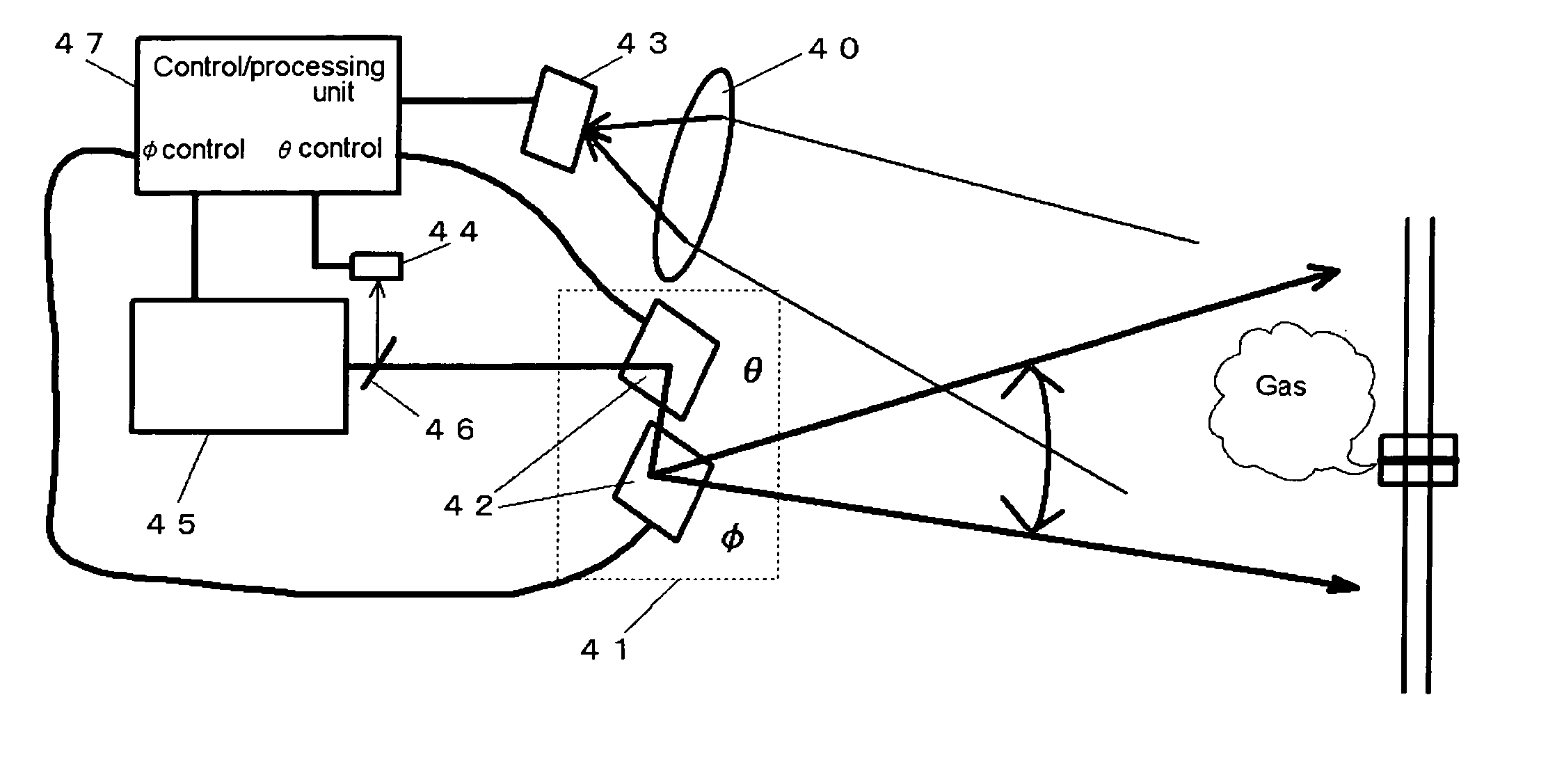Gas leakage monitoring method and its system
a monitoring method and gas leakage technology, applied in the field of gas leakage monitoring method and its system, can solve the problems of difficult to take an optimum action, difficult to locate the leakage point of hydrogen gas, device is susceptible to malfunction, etc., and achieves the effect of hardening the stoppage of the leakage gas
- Summary
- Abstract
- Description
- Claims
- Application Information
AI Technical Summary
Problems solved by technology
Method used
Image
Examples
embodiment 1
[0089]FIG. 9 shows one example the configuration of a gas leakage monitoring system according to Embodiment 1.
[0090] The system of Embodiment 1 is able to monitor leakage gas, locate a gas leakage point, monitor a flame, and to visualize a high-temperature dangerous region.
[0091] Referring to FIG. 9, numeral 10 denotes a personal computer including an image processing program. Connected to the personal computer 10 are a time synchronizing signal generator 203 and a Raman scattering light adapted camera 11a both serving as a leakage gas image pickup means, a visible light adapted camera 12 serving as a background image pickup means, an ultraviolet light adapted camera 11b serving as a flame image pickup means, and a thermo-camera 30 serving as an infrared image pickup means via cables.
[0092] Image pickup targets of the Raman scattering light adapted camera 11a and the ultraviolet light adapted camera 11b are set to the monitoring target. When an optical band-pass filter 3 is const...
embodiment 2
[0132]FIG. 13 is a schematic diagram showing an experimental system in which hydrogen is used as the target gas.
[0133] An experiment was conducted by employing the system configuration shown in FIG. 13, hydrogen gas as the target gas, and a 266-nm fourth harmonic of a YAG laser as the laser beam source. As a result, as shown in FIG. 14, the Raman scattering spectrum emitted from the hydrogen gas has an emission region about a wavelength 299.1 nm being as the center. Correspondingly, the optical band-pass filter 3 has the transmission wavelength center for a light having a wavelength of 299.1 nm and its transmission wavelength range has a half width at half maximum of 1 nm. Thus, the optical band-pass filter allows an ultraviolet light having a wavelength range of 299.1 nm±1 nm to pass through the filter, and cuts off lights of other wavelengths. When strong fluorescence is generated in an environment for measuring the Raman scattering light, the measurement can also be made using t...
embodiment 3
[0135]FIG. 16 is a schematic diagram showing the configuration of an experimental system for verifying visualization of leakage gas.
[0136] As a result of conducting an experiment for verifying visualization of leakage gas by employing the system configuration shown in FIG. 16, hydrogen gas as the target gas, and a 266-nm fourth harmonic of a YAG laser as the laser beam source, an image of the Raman scattering light was obtained as shown in FIG. 17.
[0137] The optical band-pass filter has a central wavelength of 299.1 nm, and its transmission wavelength range has a half width at half maximum of 1 nm.
[0138]FIG. 17 shows the colored images at various values of the hydrogen concentration. As shown in FIG. 17, the colored image becomes clearer by degrees as the hydrogen concentration increases.
[0139]FIG. 18 shows a visualized image of a hydrogen flame, which is obtained by coloring the image measured using the above-described system.
[0140] The optical band-pass filter has a central w...
PUM
| Property | Measurement | Unit |
|---|---|---|
| transmission wavelength | aaaaa | aaaaa |
| wavelength | aaaaa | aaaaa |
| wavelength | aaaaa | aaaaa |
Abstract
Description
Claims
Application Information
 Login to View More
Login to View More - R&D
- Intellectual Property
- Life Sciences
- Materials
- Tech Scout
- Unparalleled Data Quality
- Higher Quality Content
- 60% Fewer Hallucinations
Browse by: Latest US Patents, China's latest patents, Technical Efficacy Thesaurus, Application Domain, Technology Topic, Popular Technical Reports.
© 2025 PatSnap. All rights reserved.Legal|Privacy policy|Modern Slavery Act Transparency Statement|Sitemap|About US| Contact US: help@patsnap.com



